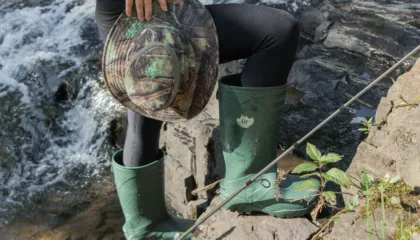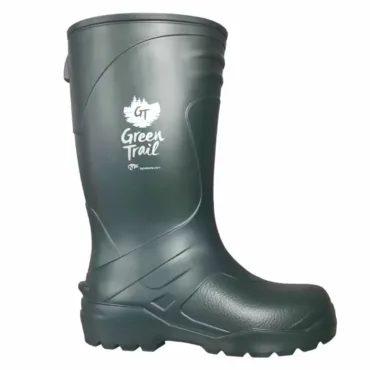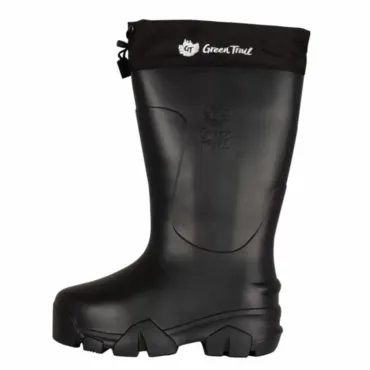EVA boots are the answer: warm, thanks to the material they're made from, they don't let moisture in. Initially designed for extreme weather conditions, EVA's other characteristics of lightness, buoyancy and cleanliness have made it a popular choice.
It is used for many purposes, including snowboarding equipment, water sports and outdoor activities. A favorite of fishermen, hunters and outdoor enthusiasts, they're perfect for many outdoor activities, whatever the season. Easy-care and durable, this ultra-lightweight material is resistant to frost and moisture. Demand for EVA boots is growing fast. Not only among ice-fishing enthusiasts, but also among city dwellers with active lifestyles.
What is EVA?
Ethylene vinyl acetate or EVA is a lightweight, flexible synthetic material made from a variety of polymers. It consists of low-molecular-weight expanded substances and organic gas. Comparable in composition to styrofoam, the air contained in the material gives it its high-quality insulating properties. Considered a thermoplastic (heat-molded by injecting material into molds), the interaction of its molecules increases at low temperatures, so the product does not lose its elasticity when cold. On the other hand, it can melt at high temperatures. Care must therefore be taken in contact with heat.
Another notable advantage is that EVA is well-suited to humid environments. Since it is non-porous, it cannot be contaminated. It is therefore totally anti-microbial and cleans easily with a wet cloth.
EVA is also very versatile, being used to make everything from toys and braces to yoga mats and cable sheaths, flip-flops and much more.
Distinctive properties of EVA footwear
Environmentally-friendly, EVA production uses no glue or artificial rubber, as with other types of boots. Nor does it use tannins, as with leather products. As a result, these boots are suitable for children and people with sensitive skin, since they don't cause allergies.
The comfort of this material is unrivalled; light, supple and shock-absorbing, it is ideal for a wide range of uses. What's more, its hygienic properties are incomparable. Since EVA does not absorb moisture, it dries quickly, is easy to clean, has no unpleasant odors and does not accumulate bacteria.
Since the boots have no seams (they are molded in one piece), they are resistant to extreme environmental conditions. Dense in composition, they form a weather barrier around your feet. So, you won't have to worry about water, snow, dirt or chemical fertilizers. For the same reason, they retain heat perfectly without letting in the cold. Indeed, the first generation of boots was much appreciated by ice fishermen. In fact,
the first models were produced with them in mind, to protect their feet from freezing and getting wet from prolonged exposure to icy water.
Advantages and disadvantages of EVA boots
The wonderful characteristics of the material inspired us to diversify our EVA-based products. Today, it's a material we use in many of our products. But this material has a number of special features that need to be explained.
Firstly, EVA is flexible and can be long-lasting. However, as it is a rather soft material, small cracks may appear at the points of curvature,
but the product will not lose its insulating properties due to the thickness of the walls and the profiled sole.
Secondly, EVA is ideal for use at low temperatures. Our boots can withstand temperatures of -70° C. A good way to keep your feet warm is
to choose the removable liner option. It's also practical for maintenance. After outdoor use, we recommend removing the liner so that it dries properly and doesn't accumulate perspiration, or wiping the inside of the boot with a cloth.
Extremely lightweight, EVA boots don't restrict the foot on long walks. And the boot's monocoque structure ensures even weight distribution. It also provides the cushioning your feet need when walking; important criteria when choosing footwear for children and the elderly.
Its flexible nature makes it extremely comfortable, but also less resistant to wear caused by friction with hard, rough surfaces such as asphalt, concrete and stones. So, EVA boots are not suitable for prolonged daily use (if you wear them every day, for hiking, they will last a good season but will have to be replaced for the following season).
Nor can EVA boots be stretched by stretch shoe lasts (as with leather shoes). So, it's vital to choose the right size. (This is important. The size
of the foot varies, during the day, by one cm and increases with physical activity. If you wear ill-fitting shoes all day long, your feet will be sore and irritated.)
As a general rule, manufacturers will help you choose the right size, according to their size chart. A pair of shoes or boots should be selected according to the size of your feet and the type of activity you'll be doing. Sometimes, you'll be offered a size larger than your shoe size, so that you can insert a liner and use your boot for the winter season. But beware, improper care can irreparably damage the product: EVA is sensitive to high temperatures. Consequently, near an open flame or a source of high heat, it can melt and/or warp. Boots can also lose their structure irreversibly under heavy external pressure. The material is sensitive to mechanical damage.
-
 Read more +
April 19, 2024 By A.A Rochon in Blog
Read more +
April 19, 2024 By A.A Rochon in Blog
OUR TIPS FOR CHOOSING THE RIGHT FISHING HAT
-
 Read more +
By A.A Rochon in Blog
Read more +
By A.A Rochon in Blog
TYPES OF FISHING HATS AND THEIR CHARACTERISTICS
-
 Read more +
March 19, 2024 By A.A Rochon in Blog
Read more +
March 19, 2024 By A.A Rochon in Blog
5 REASONS TO CHOOSE A PAIR OF MERINO WOOL SOCKS
-
 Read more +
February 28, 2023 By Sylvain in Blog, L'Heureux Family
Read more +
February 28, 2023 By Sylvain in Blog, L'Heureux Family
Light casting rod PRESTIGE (9642200) by Yannick
-
 Read more +
By Sylvain in Blog, L'Heureux Family
Read more +
By Sylvain in Blog, L'Heureux Family
Folding landing net (9675071) by Yannick
-
 Read more +
February 27, 2023 By Sylvain in Archibald, Blog
Read more +
February 27, 2023 By Sylvain in Archibald, Blog
PORK LOIN À LA JOUFFLUE








